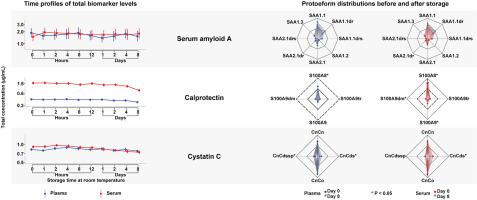Talanta ( IF 6.1 ) Pub Date : 2020-10-14 , DOI: 10.1016/j.talanta.2020.121774 Jie Gao , Arve Ulvik , Adrian McCann , Per Magne Ueland , Klaus Meyer

|
Protein biomarker microheterogeneity has attracted increasing attention in epidemiological and clinical research studies. Knowledge concerning the preanalytical stability of proteins is paramount to assess the biological significance of their proteoforms. We investigated the stability of the inflammatory markers C-reactive protein (CRP), serum amyloid A (SAA), and calprotectin (S100A8/9), and the renal function marker, cystatin C (CnC). In total 16 proteoforms were quantified by immuno-MALDI-TOF MS in EDTA plasma and serum samples from 15 healthy volunteers. Prior to analysis blood samples were stored at either room temperature from 1 hour up to 8 days, or underwent up to 9 consecutive freeze/thaw cycles. Pearson’s correlation coefficient and t-test, intra-class correlation coefficient (ICC), and Autoregressive Integrated Moving-Average (ARIMA) models were used to investigate the stability of proteoform concentrations and distributions in blood. Plasma and serum concentrations of CRP and SAA proteoforms were highly stable during room temperature exposure and repeated freeze/thaw cycles, demonstrating excellent repeatability (ICC > 0.75), no serial dependency in ARIMA models, and stable distribution of proteoforms. Stability analyses for proteoforms of S100A8/9 and CnC identified only minor preanalytical changes in concentrations and distributions, and none of the proteoforms were produced during prolonged exposure to room temperature or repeated freezing/thawing. The four proteins and their proteoforms are stable during sub-optimal sample handling, and represent robust biomarker candidates for future biobank studies aimed at investigating the microheterogeneity of SAA, S100A8/9, and CnC in relation to inflammation, renal dysfunction and various clinical outcomes.
中文翻译:

炎症和肾功能的蛋白质生物标志物的微异质性和分析前稳定性
蛋白质生物标志物的微异质性已在流行病学和临床研究中引起越来越多的关注。有关蛋白质的分析前稳定性的知识对于评估其蛋白形式的生物学意义至关重要。我们调查了炎症标志物C反应蛋白(CRP),血清淀粉样蛋白A(SAA)和钙卫蛋白(S100A8 / 9)和肾功能标志物胱抑素C(CnC)的稳定性。通过免疫MALDI-TOF MS对15位健康志愿者的EDTA血浆和血清样品中的16种蛋白进行了定量。在分析之前,将血液样品在室温下保存1小时至8天,或进行9次连续的冷冻/解冻循环。皮尔逊相关系数和t-检验,组内相关系数(ICC)和自回归综合移动平均(ARIMA)模型用于研究蛋白形式浓度和血液中分布的稳定性。CRP和SAA蛋白形式的血浆和血清浓度在室温暴露和反复的冻融循环中高度稳定,显示出极好的可重复性(ICC> 0.75),ARIMA模型中无序列依赖性,并且蛋白形式稳定分布。对S100A8 / 9和CnC的蛋白形式进行稳定性分析,发现分析前浓度和分布仅发生很小的变化,长时间暴露于室温或反复冷冻/融化过程中均未产生任何蛋白形式。四种蛋白质及其蛋白形式在次优样品处理过程中稳定,


























 京公网安备 11010802027423号
京公网安备 11010802027423号